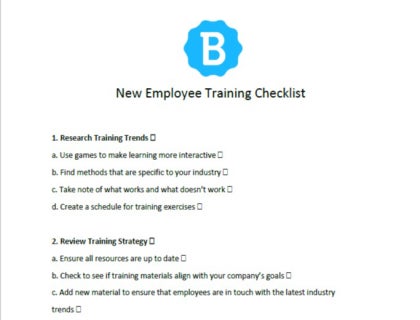
New Employee Training Checklist
Use this free employee training checklist as a guide the next time you are in the process of training your employees.
Download NowHow to Train New Employees:

Five easy steps on how to train new employees.
Review your training strategy.
Make sure your training material aligns with company goals.

Over time, a company's goals could develop or change, making it important that your training material grows with the company. Read through your training material and set aside outdated resources that no longer align with your company's mission statement.
Ensure all resources are up to date.

Whether you've isolated outdated PowerPoint presentations or eBooks, make sure your resources include material that's fresh and engaging. For job positions that require a lot of computer work, check that your devices are updated and working to ensure a smooth training session.
Identify what works and what doesn’t.

Identify which training methods have helped you before to single out techniques that could be updated or reused. Once you've isolated these methods, assess how they complement or contrast with your training session's subject matter and your company's goals.
For example, dense theory work that typically comes in the form of printed notebooks could be replaced by interactive online guides and/or games to help communicate the same information more concisely.
Research new training trends.
Consider interactive training methods.

Think about adding enjoyable activities to training sessions to make them more participatory and engaging. Whether you're offering treasure hunts, online training, or peer-to-peer learning, training methods that require interaction have the power to instantly foster camaraderie, and they help make the training session fun and memorable.
Find trends that are specific to your industry.

When researching training trends, consider those specific to your industry. For example, businesses in adventurous industries might opt for interactive and physical games, while customer service-centered businesses might appreciate role-playing or case studies. Either way, it's important that your training feels distinct and informative.
Start your preparations.
Identify the training sessions' goals.

Before you start preparing your training material, make sure that you're clear on the goals of the training session. For instance, what are the primary outcomes of the training session? Which subjects will your training focus on, and why? Once you've compiled a clear list of goals, start preparing your presentation.
Tailor your training material.

While some training subjects such as workforce etiquette and company policies are created for all employees, there are certain subjects that are applicable to different departments. Depending on the employee(s) you're training, adjust your training material to match their daily job expectations.
Rehearse your presentation and ask for feedback.

Once you've completed your presentation, rehearse it in front of a group of trusted peers. Allow room for questions and ask your peers for their honest feedback. Depending on their responses and suggestions, tweak your presentation accordingly.
Create a training schedule.

Set up a timeline for your training exercises to ensure a seamless process. Knowing your timeline will also help you place a deadline on your training material preparations.
In addition to designated lunches and theory work, allow ample time for questions. Giving new employees the freedom to ask questions is vital if you want them to feel comfortable with their work.
Start your training sessions.
Explain the purpose of each training session.

Before proceeding with your training sessions, open up communication with new employees by explaining the purpose and outcomes of each training session. This helps define your training sessions' goals and gives the new employee(s) an idea of what to expect.
Conduct the training session.

Ensure that your training sessions are productive and efficient through clear planning and good time management. To help simplify the information provided in training, include material that's concise and legible, and depending on the training method you choose, leave plenty of room for questions and open discussions.
Hand out a short assessment at the end of training.

As the employer, it's important that you're able to assess the success of your training session. This can be accomplished through short surveys or assessments that cover the training session's key points. With surveys, you'll be able to gauge new employees' opinions and feedback, while assessments highlight how much they've learned.
Provide feedback.
Review assessments and provide feedback in writing or in person.

Maintain communication with new employees by inviting them for feedback sessions. Ask plenty of questions about their job duties and how they align with your training material. Additionally, comb through their assessments and identify areas that require further training.
Allow time for one-on-one sessions to give personalized feedback. In these sessions, make sure that you compliment the employee in areas where they excelled. Finally, discuss the road forward in terms of follow-up training sessions.
Review your training methods periodically.

To ensure that your training methods remain compelling and relevant, review and update your training techniques periodically. This can be aided by the feedback received from employees over time, which may help you better understand what they appreciate or dislike about your training sessions.
Additionally, make sure to stay informed on the latest developments in the training sector. For instance, the e-learning training approach is continuously changing as more companies choose online and remote learning. This has resulted in an influx of innovative platforms that are creative and engaging.
New Employee Announcement Email Template
Ways to Improve Your Training:
1. Make sure that it's targeted to the employees.
Don't make your engineers sit through the same training as your sales team. Target your training as finely as you can so that you can relate it directly to how it helps individuals perform in their jobs.
2. Make it real by having trainees use the training immediately.
After the training, give employees a task that actually requires them to use what they've just learned. It will help them cement the learning and will show you exactly where they still need work.
3. Make training more enjoyable.
Training doesn't have to be a drag. Take breaks and build in time to socialize. Don't let training become synonymous with boredom at your company.
4. Train them when they need it.
Don't train now for something an employee will need in two months. Segment employee training, and try to plan it so that they'll be using it as much as possible after the training is over. They'll retain more and you'll waste less time having to retrain overloaded employees.
Top Training Methods:
E-learning.
E-learning, also referred to as "online learning," is a popular training method that uses remote, online-based training programs. With many online programs offering games, fun lessons, and quizzes that make the training feel more advanced and engaging, this method of training can be extremely effective.
In addition, depending on the program you use, you can include video content and live presentations. That said, setting up graphics and information for e-learning systems can take time, and training officials may need to undergo additional training to better manage the system you choose.
Microlearning.
Microlearning is based on short and concise training sessions that last between five and 10 minutes. Each training session has a specific goal set before it starts, providing structure and short-term goals to work toward. The short training sessions are also great for helping new employees feel less overwhelmed with the new information.
However, while microlearning is great for low-stakes positions, the short sessions may not work for businesses that require more complex training, as time constraints could impact the amount of information covered.
Job shadowing.
Job shadowing, a more traditional training method, has proven to be effective in occupations that necessitate plenty of practical work. To better understand the workforce of the company, employers may choose to pair new hires with one person who will guide them, or they can have new hires job shadow employees in various departments.
While job shadowing is also effective for fostering relationships and great communication between new and established employees, it may not work for fast-paced environments where new hires won't have time to ask questions or interact. Additionally, job shadowing works best when new employees already have prior experience in the role.
Instructor training.
An instructor leading a training session is often seen as the standard means of training. But, while the method has become more outdated, it remains one of the most effective methods of training. This is largely thanks to its interactive format, which enables new hires to interact with trainers and ask questions in real-time.
Employers can also cover more material during instructor-led training, which makes it a good option for covering complex job requirements. For new employees, however, these training sessions may feel monotonous, especially if they are followed by long periods of information dumping.
Role-playing.
Role-playing, or "simulation training," is a well-known method for positions requiring direct contact with customers. In these training sessions, trainers and trainees will assume the role of customer and employee, respectively, and act out possible scenarios that may occur on the job.
This type of training allows new hires to understand the role better and receive feedback that's more useful. That said, role-playing is a more practical approach to training that might not suit everyone's style of learning. In addition, certain scenarios could feel needless, especially if the new hire has plenty of prior experience in the role.
Collaborative training.
With collaborative training, various employees share their experiences and knowledge to help both established employees and new hires learn from one another. This method of training is great for aiding communication between employees, and the experience can encourage new hires to interact more.
Collaborative training is best suited for roles that don't require complex routines and tasks, but in cases where job roles may be more in-depth, companies opt to add instructor-led training. This often extends the training period, which could impact costs and employees' work schedules.
Peer-to-peer learning.
Similar to collaborative learning and job shadowing, peer-to-peer learning requires current employees to help train new hires. Unlike job shadowing, current employees are expected to fulfill the role of trainer completely, which could impact their work schedule and performance.
While this method of training is highly effective in collaborative projects, it will require a lot of commitment and time from current employees, who'd need to be able to measure the new hire's success through continuous assessments and discussions.
Get Strategic with Your Training for Long-Term Gains:
Statistics show most companies spend more money on coffee than training. If the goal is to have a high-performing workforce, companies need to spend the resources to develop employees. Aligning resources to goals is the strategy.
If you allocate more resources to training, you can be sure someone will want to see measurable benefits — as they should.
So, set goals, and create a simple measurement process for your training so you can see the results.
One number you can use to measure effectiveness is employee turnover. Better training should reduce turnover. You can measure turnover by calculating your churn rate.
Look at your historical rate of voluntary turnover and see if improved training helps decrease it. To measure if employees are really absorbing new training, you can have them turn around and train other employees on what they've learned.
This leads us to another way of getting strategic with training: cross-training.
Besides being a way to measure what an employee has learned, cross-training allows for career growth and development, satisfying your employees’ desire to learn new skills, while allowing you to increase office coverage. So, if one employee is out, there’s always someone who understands their job.
As your company puts more strategic focus on training and spending surpasses coffee levels, it may become the type of company that puts employees first.
Companies that use the strategy of putting employees first gain enormous competitive advantages and end up with happier customers as a result. The key to an employee-first company? Training and developing your workforce. It's the approach of companies like Southwest Airlines and Virgin.
For companies that put employees first, including Richard Branson's, a good training strategy essentially becomes a good business strategy. Whether you decide to focus your priorities on employees or not, it should be clear that better training makes better companies and happier customers.
Signs of a Poor New Employee Training Program:
1. The purpose of the training is ambiguous.
Have you ever sat in a training session and wondered, why am I here? Training that has no connection to day-to-day tasks will most likely fail. Show employees exactly how it pertains to their job and the company's mission.
2. Employees are afraid to fail.
Instead of training employees and expecting them to execute perfectly, give them a chance to fail. Let them use what they've learned without fear of repercussions if they make a few mistakes.
3. No feedback is provided.
This is especially important for millennials. Employees want to know if they're doing a good job and where they can improve. Don't leave them in the dark about their performance.
4. You assume employees don't want training.
Often, employees don't ask for training, but it has nothing to do with their desire to learn. They may be unsure how to ask, afraid of rejection, or under the impression that it will make them look incapable. Most employees want opportunities for professional development and will be glad if you offer them.



